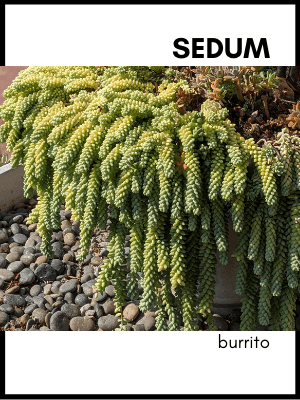Sedum burrito, also known as Burro’s Tail, is a popular succulent with long, trailing stems and cylindrical blue-green leaves. The leaves grow in clusters along the stems, resembling the tail of a burro or donkey, giving this sedum its whimsical name. It produces pink or red-tinged white flowers in late summer.
Sedum burrito ‘Burro’s Tail’ grows best in bright light and well-draining, sandy soil. It tolerates some shade but may get leggy. Only water when soil is dry to avoid rot. It can be grown hanging or trailing from containers or rock walls. It is cold hardy to 30 F. With its fun foliage and trailing habit, Sedum burrito works great in succulent arrangements and as a unique hanging plant. Sedum burrito ‘Burro’s Tail’ does best with regular inspection for pests or excess moisture and adjustment of light and watering as needed.

How to Propagate Burro’s Tail
To produce more of your beloved Sedum burrito ‘Burro’s Tail’ succulent, you’ll need to take some cuttings from your main plant and encourage those clippings to grow roots and shoots of their own. It’s not difficult, but takes some time and the right conditions.
Start by collecting some healthy 4-6 inch stem segments from your Sedum burrito ‘Burro’s Tail’. Choose stems with clusters of plump leaves – these will have the best chance of success in rooting. Use sharp, clean shears or scissors to snip just below a leaf node, where a pair of leaves attach to the main stem.
After cutting, lay the segments out on a paper towel for 1-2 days until the cut ends dry out and callus over. This hardening of the cut prevents infection while also helping the stem absorb more of the rooting hormone in the next step.
Once dry, dip the cut end of each segment in rooting hormone, if desired. This can speed up the root growth time, but is not required if you are patient. Then plant each segment in well-draining potting soil, burying 1-2 inches of the cut end in the soil.
The key now is to keep the soil lightly moist and place your new cuttings in a warm spot with bright, indirect light. A heating mat can help keep temperatures ideal for root growth. Expect to wait 4-6 weeks before checking for new roots emerging from the cut end of the stems.
Once your cuttings have rooted, gradually expose them to more direct sun and less humidity to allow them to toughen up. After a week or two of this hardening off process, you’ll have new fully-rooted Sedum burrito ‘Burro’s Tail’ starts ready to grow into full-size trailing beauties! Let me know if you have any other questions about propagating your Sedum burrito ‘Burro’s Tail’.
How can I tell if my Sedum burrito ‘Burro’s Tail’ is getting too much or too little light?
Some signs that your Sedum burrito ‘Burro’s Tail’ is getting too much light include:
Leaves turning brown or reddish, especially at the tips
Stems becoming bare as leaves drop off
Increased risk of sunburn in very hot direct sun
Signs of too little light include:
Stems becoming elongated and sparse as the plant stretches for light
Leaves turning pale green or yellowish
Minimal new growth and lack of flowering
To correct lighting issues:
Too much light: Move to a spot with bright indirect light or install a sheer curtain over a sunny window.
Too little light: Move to a brighter spot or use a grow light to provide 14-16 hours of light per day.
With the right amount of illumination, your Sedum burrito ‘Burro’s Tail’ will grow compact and trail beautifully. Light conditions may need adjusting seasonally based on the intensity of natural light.
- Hardy to USDA Zone: 10a
- Size: Trails well over 12″ if left alone
- Foliage: Light green
- Flower: Pink/peach
- Propagation: Stem cuttings, leaves, seed
- Light: Can handle full sun if acclimated, bright shade
- Water: Drench & Dry
- Soil: Gritty, mostly inorganic, quickly draining
- Origin: Veracruz, Mexico
Sedum burrito (Moran, 1977) is different from Sedum morganianum ‘Burro’s Tail’ in that its leaves are shorter and rounded at the end and the flowers are completely different.
I have been growing my Sedum burrito in my succulent fountain for about 3 years now and the biggest piece of advice I can give to people who are having problems with theirs is to LEAVE IT ALONE. Once you find a spot that it likes, Do. Not. Move. It.
The leaves are super fragile and seem to pop off when you glance in its general direction much less touch it. This is definitely a succulent that will not do well if you fuss with it too much.
Definitely check out: How to Water Succulents So They Don’t Die
Sedum burrito propagates super easily by leaf. The trick is to take a BUNCH of leaves, put them on top of the soil in its forever pot and keep it moist once roots start forming. Be sure to give it lots of ventilation at the same time. Sedum burrito roots are tiny and any movement damages them. All of the nurseries I’ve visited in San Diego propagate their pots this way.
You might like: My Succulent Leaves Are Turning Yellow
Protect them from frost and extreme heat. They must have lots of bright light to prevent etiolation and keep their compact, trailing shape. Not enough light and you’ll see lots of room between the leaves which means the stem is also weaker.
Quick question: Should you mist succulents? Find that answer here.

